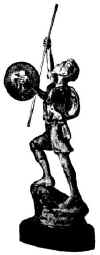by Edward Reimer

Scout with Staff
Design by Sir Robert Baden-Powell
The Boy Scout Staff has a score of practical uses. When Sir Robert Baden Powell designed his bronze "Scout with Staff" he gave the staff the loftiest and most prominent place in the statue. Patrol Leaders give similar prominence to the staff. Each Patrol Leader carries a small flag on the end of his staff or stave with the head of his Patrol animal shown on both sides. Thus the Tigers of the Twenty-Seventh New York Troop carry their Patrol flag on the sturdy serviceable staff.

Patrol Flag & Staff of
27th New York Tigers
PRACTICAL USES OF THE STAFF
Some of the practical uses of the Scout staff are told in these pictures:

Practical Uses of the Staff
![]()

More Uses
![]()

Patrol Sketchbook
![]()
by Robert Baden-Powell
Scout Staff
The Scout staff is a useful addition to the kit of the Scout. Personally, I have found it an invaluable assistant when traversing mountains or boulder-strewn country and especially in night work in forest or bush. Also, by carving upon it various signs representing his achievements, the staff gradually becomes a record as well as a treasured companion to the Scout.
The Scout staff is a strong stick about as high as your nose, marked in feet and inches for measuring.
The staff is useful for all sorts of things, such as making a stretcher, keeping back a crowd, jumping over a ditch, testing the depth of a river, keeping in touch with the rest of your Patrol in the dark. You can help another Scout over a high wall if you hold your staff horizontally between your hands and make a step for him; he can then give you a hand from above.
Several staves can be used for building a light bridge, a hut or a flag staff.
There are many other uses for the staff. In fact, you will soon find that if you don't have your staff with you, you will always be wanting it.
If you get the chance, cut your own staff. But remember to get permission first

The Scout staff is useful for a great number of out-door activities.